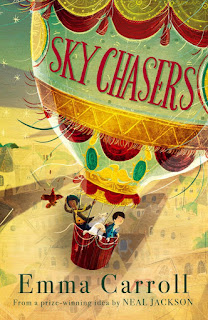Bridie Sweeney wants to tell you a better story, a more truthful story, a less tragic story about the real little match girl. The year is 1887 (the year my own Grandmother Amy Elizabeth was born).
The old story was "so sweet and sad, people would snivel into their hankies upon reading it, and it soon because famous the world over. It made the man who wrote it very rich indeed, though I don't suppose he'd ever met a real match girl in his life. If he had he'd have know we weren't all pretty things with fair curls and tiny, freezing hands, and that most of us were fed up with being hungry all the time."
Bridie lives with her mother, who works at the match factory, and her younger brother Fergal. They live in a tiny room and just scrape by with small wages from the factory and the few coins Bridie makes selling matches in London's East End.
Conditions in the factory are dreadful. Mam, and the other women who work there, are subject to the poison of the phosphorus from the matches (phossy jaw). There is no ventilation in their work space and they cannot wash their hands before eating.
"I couldn't imagine how bad it was inside the factory building. Mam was a dipper, dunking the matchsticks in phosphorus, which meant she - and many others like her - stood bent over the stuff all day long without so much as an open window for air."
The factory is based on the real one The Bryant and May factory. Here are their match boxes:
Bridie sets out to sell her matches and on this day things go well at first. She sells all of her boxes and is able to pick up another set from the factory. But this is when things go badly wrong. She is nearly killed when a carriage containing the factory boss hits her. All of her matches are spilled, her tray is smashed and the too big slippers, which belong to her mam, are lost. Bridie has only three damaged matches left. She strikes each of them in turn, and, as in the original tale, she enters a series of visions. She experiences the excesses of the rich factory boss and his family at their dining table. Then she meets a activist who wants to support the factory workers and demand change. Finally she is given a glimpse of her final wish - "I wish to see my family living a better life".
This is historical fiction at its best. At the back of the book there are notes which explain the context of factory workers, match production, the role of the activist Annie Besant (1847-1933) who published letters in newspapers all over England which led people to support the striking factory workers. It all takes a long time but by 1908 the use of white phosphorus is banned.
The production of this book is scrumptious! Yes I am using the word scrumptious. This hardcover book costs under AUS$20 and it has a dust jacket (you know I adore them) and a different image under the jacket (another aspect of book design that I really appreciate). The illustrations by Lauren Child are perfect too. If you have a young reading companion aged 10+ I highly recommend this book. It would be a perfect Christmas present.
Further reading
I would follow this book with these:
Of course you will also want to revisit the original story. Some very talented people have illustrated versions of this famous Hans Christian Andersen fairy tale - Jerry Pinkney; Rachel Isadora; Kveta Pacovska; Kestutis Kasparavicius and Hye-Won Yang.
I have previously talked about several books by Emma Carroll:












No comments:
Post a Comment